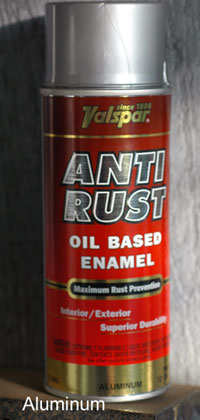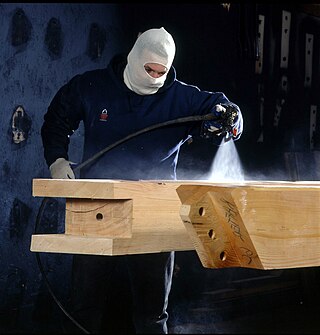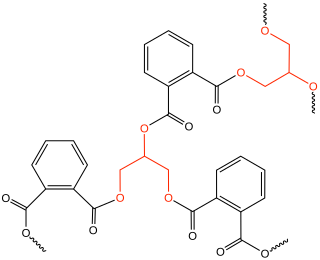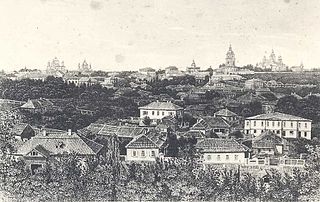
Paint is a liquid pigment that, after applied to a solid material and allowed to dry, adds a film-like layer, in most cases to create an image, known as a painting. Paint can be made in many colors and types. Most paints are either oil-based or water-based, and each has distinct characteristics.

Desert varnish or rock varnish is an orange-yellow to black coating found on exposed rock surfaces in arid environments. Desert varnish is approximately one micrometer thick and exhibits nanometer-scale layering. Rock rust and desert patina are other terms which are also used for the condition, but less often.

Shellac is a resin secreted by the female lac bug on trees in the forests of India and Thailand. Chemically, it is mainly composed of aleuritic acid, jalaric acid, shellolic acid, and other natural waxes. It is processed and sold as dry flakes and dissolved in alcohol to make liquid shellac, which is used as a brush-on colorant, food glaze and wood finish. Shellac functions as a tough natural primer, sanding sealant, tannin-blocker, odour-blocker, stain, and high-gloss varnish. Shellac was once used in electrical applications as it possesses good insulation qualities and seals out moisture. Phonograph and 78 rpm gramophone records were made of shellac until they were replaced by vinyl long-playing records from 1948 onwards.

Varnish is a clear transparent hard protective coating or film. It is not to be confused with wood stain. It usually has a yellowish shade due to the manufacturing process and materials used, but it may also be pigmented as desired. It is sold commercially in various shades.

Lacquer is a type of hard and usually shiny coating or finish applied to materials such as wood or metal. It is most often made from resin extracted from trees and waxes and has been in use since antiquity.

Enamel paint is paint that air-dries to a hard, usually glossy, finish, used for coating surfaces that are outdoors or otherwise subject to hard wear or variations in temperature; it should not be confused with decorated objects in "painted enamel", where vitreous enamel is applied with brushes and fired in a kiln. The name is something of a misnomer, as in reality, most commercially available enamel paints are significantly softer than either vitreous enamel or stoved synthetic resins, and are totally different in composition; vitreous enamel is applied as a powder or paste and then fired at high temperature. There is no generally accepted definition or standard for use of the term "enamel paint", and not all enamel-type paints may use it.
Water-miscible oil paint is oil paint either engineered or to which an emulsifier has been added, allowing it to be thinned and cleaned up with water. These paints make it possible to avoid using, or at least reduce volatile organic compounds such as turpentine that may be harmful if inhaled. Water-miscible oil paint can be mixed and applied using the same techniques as traditional oil-based paint, but while still wet it can be removed from brushes, palettes, and rags with ordinary soap and water. One of the ways its water solubility comes from is the use of an oil medium in which one end of the molecule has been engineered to be hydrophilic and thus bind loosely to water molecules, as in a solution. This type of paint is different to those that are engineered to enable cleaning of brushes and application equipment in water but are not in themselves water reducible.

Wood stain is a type of paint used to colour wood comprising colourants dissolved and/or suspended in a vehicle or solvent. Pigments and/or dyes are largely used as colourants in most stains.

A primer or undercoat is a preparatory coating put on materials before painting. Priming ensures better adhesion of paint to the surface, increases paint durability, and provides additional protection for the material being painted.

Wood finishing refers to the process of refining or protecting a wooden surface, especially in the production of furniture where typically it represents between 5 and 30% of manufacturing costs.

A desert pavement, also called reg, serir, gibber, or saï is a desert surface covered with closely packed, interlocking angular or rounded rock fragments of pebble and cobble size. They typically top alluvial fans. Desert varnish collects on the exposed surface rocks over time.

An alkyd is a polyester resin modified by the addition of fatty acids and other components. Alkyds are derived from polyols and organic acids including dicarboxylic acids or carboxylic acid anhydride and triglyceride oils. The term alkyd is a modification of the original name "alcid", reflecting the fact that they are derived from alcohol and organic acids. The inclusion of a fatty acid confers a tendency to form flexible coatings. Alkyds are used in paints, varnishes and in moulds for casting. They are the dominant resin or binder in most commercial oil-based coatings. Approximately 200,000 tons of alkyd resins are produced each year. The original alkyds were compounds of glycerol and phthalic acid sold under the name Glyptal. These were sold as substitutes for the darker-colored copal resins, thus creating alkyd varnishes that were much paler in colour. From these, the alkyds that are known today were developed.

Zincography was a planographic printing process that used zinc plates. Alois Senefelder first mentioned zinc's lithographic use as a substitute for Bavarian limestone in his 1801 English patent specifications. In 1834, Federico Lacelli patented a zincographic printing process, producing large maps called géoramas. In 1837–1842, Eugène-Florent Kaeppelin (1805-1865) perfected the process to create a large polychrome geologic map.
Xylotechnigraphy is an architectural term for a decorative treatment to wood. By staining, finishing, and graining, the wood resembles a more expensive or finer type. The process was invented by A. F. Brophy and patented in England in 1871.

Pontypool japan is a name given to the process of japanning with the use of an oil varnish and heat, which is credited to Thomas Allgood of Pontypool. In the late 17th century, during his search for a corrosion-resistant coating for iron, he developed a recipe that included asphaltum, linseed oil and burnt umber. Once applied to metal and heated the coating turned black and was extremely tough and durable.
Metalization may refer to one of a number of different processes:
The chemical resistance of a material or surface can be determined in compliance with ISO 2812 Paints and varnishes – Determination of resistance to liquids – Part 1: Immersion in liquids other than water ; German Version EN ISO 2812-1:2007 or Part 4: Spotting methods ; German Version EN ISO 2812-4:2007. With these methods, a material or surface is exposed to the relevant chemical for a longer, defined period of time and the relevant area then inspected microscopically. Possible changes which could occur include:












